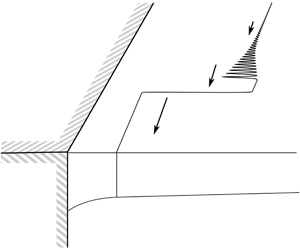Article contents
The long-wave potential-vorticity dynamics of coastal fronts
Published online by Cambridge University Press: 07 February 2020
Abstract

This paper studies the propagation of free, long waves on a potential vorticity front in the presence of a vertical coast, using a  $1{\textstyle \frac{1}{2}}$-layer, quasi-geostrophic model with piecewise-constant potential vorticity. The coastal boundary induces flow through image vorticity and a Kelvin wave, either of which can reinforce or oppose the Rossby wave dynamics at the front. The behaviour of the front depends strongly on the relative strengths of these three mechanisms, which are explicit in our model. The richest behaviour, which includes kink solitons (under-compressive shocks) and compound-wave structures, occurs in the regime where vortical effects are dominant. The evolution of the front is described by a fully nonlinear finite-amplitude equation including first-order dispersive effects, which is related to the modified Korteweg–de Vries equation. The different behaviours are classified using the canonical example of the Riemann problem, which we analyse using El’s technique of ‘dispersive shock-fitting’. Contour-dynamic simulations show that the dispersive long-wave theory captures the behaviour of the full quasi-geostrophic system to a high degree of accuracy.
$1{\textstyle \frac{1}{2}}$-layer, quasi-geostrophic model with piecewise-constant potential vorticity. The coastal boundary induces flow through image vorticity and a Kelvin wave, either of which can reinforce or oppose the Rossby wave dynamics at the front. The behaviour of the front depends strongly on the relative strengths of these three mechanisms, which are explicit in our model. The richest behaviour, which includes kink solitons (under-compressive shocks) and compound-wave structures, occurs in the regime where vortical effects are dominant. The evolution of the front is described by a fully nonlinear finite-amplitude equation including first-order dispersive effects, which is related to the modified Korteweg–de Vries equation. The different behaviours are classified using the canonical example of the Riemann problem, which we analyse using El’s technique of ‘dispersive shock-fitting’. Contour-dynamic simulations show that the dispersive long-wave theory captures the behaviour of the full quasi-geostrophic system to a high degree of accuracy.
Information
- Type
- JFM Papers
- Information
- Copyright
- © The Author(s), 2020. Published by Cambridge University Press
References
- 4
- Cited by

